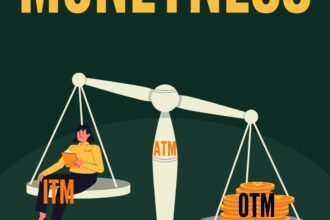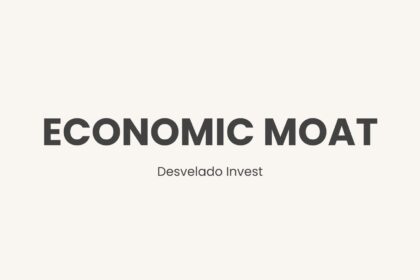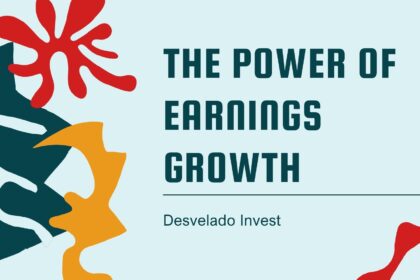Written By: Eklavya Guneja
Hey there! Are you curious about how options work in the stock market but find the terms confusing? You’re in the right place! This guide breaks down the essential concepts of options with relatable examples. Let’s get started!
Key Options Terminology and Moneyness
To navigate the world of options, it’s essential to understand some key terms, especially when it comes to moneyness. Moneyness indicates whether an option is profitable to exercise based on the current stock price. There are three types:
- In-the-Money (ITM)
- At-the-Money (ATM)
- Out-of-the-Money (OTM)
Let’s break these down with simple examples.
1. In-the-Money (ITM)
An option is In-the-Money when exercising it would result in an immediate profit. For call options, this happens when the current price of the stock is higher than the strike price. For put options, it’s when the current price of the stock is lower than the strike price.
Example: Suppose Amit buys a call option for HDFC Bank with a strike price of ₹1,500, expiring in one month.
- Current Price of HDFC Bank: ₹1,600
- Moneyness: ITM
- Why It’s ITM: Amit can buy HDFC Bank shares at ₹1,500 and sell them at ₹1,600, making a profit of ₹100 per share (excluding the premium paid for the option).
Practical Implication:
Imagine Raj, a small business owner in Mumbai who manufactures furniture. His business relies heavily on imported wood, and he knows that wood prices tend to fluctuate due to global market conditions. Raj expects wood prices to rise significantly in the coming months, but he doesn’t want to buy and store large amounts of wood immediately due to limited storage space and cash flow constraints.
To manage this risk, Raj purchases ITM call options for wood at ₹1,000 per cubic meter, which is slightly below the current market price of ₹1,050. This ensures that if wood prices rise, he can still buy it at ₹1,000 per cubic meter, locking in his costs.
How It Benefits Raj:
- Cost Savings: A month later, the price of wood rises to ₹1,200 per cubic meter. Thanks to his ITM call options, Raj exercises his right to buy at ₹1,000, saving ₹200 per cubic meter. Please note that, even if wood prices fall to ₹1,025 per cubic meter. Raj’s ITM call options saves him ₹25 per cubic meter.
- Risk Management: Raj avoids paying higher market prices and secures a steady cost for his raw materials, allowing him to price his furniture competitively.
- Flexibility: If wood prices had dropped below ₹1,000, Raj could have chosen not to exercise the option, losing only the premium he paid but avoiding overpaying for materials.
2. At-the-Money (ATM)
An option is At-the-Money when the current stock price is equal to the strike price. Exercising it doesn’t lead to any profit or loss—it’s neutral.
Example:
Using the same scenario, if HDFC Bank’s current price is exactly ₹1,500:
- Current Price of HDFC Bank: ₹1,500
- Moneyness: ATM
- Why It’s ATM: The strike price is equal to the current price, so there’s no immediate profit or loss if Amit exercises the option.
Practical Implication:
Let’s say Priya, an individual investor, is keeping an eye on HDFC Bank’s stock because the company is about to announce its quarterly earnings. Priya believes this announcement could significantly impact the stock price, but she’s unsure whether it will rise or fall.
Instead of buying HDFC Bank’s stock directly, which costs ₹1,500 per share, Priya chooses to purchase ATM call options with a strike price of ₹1,500 for a premium of ₹50 per share. Here’s why:
- Lower Upfront Cost:
If Priya buys 100 shares of HDFC Bank directly, she needs ₹1,50,000. However, by purchasing 100 ATM call options, she only pays ₹5,000 (₹50 premium × 100 shares). This allows Priya to take a position in the market with significantly less capital. - Balanced Risk and Reward:
- If HDFC Bank’s stock rises to ₹1,600 after the announcement, Priya can exercise her option to buy at ₹1,500 and immediately sell at ₹1,600, making a profit of ₹50 per share (₹100 gain minus ₹50 premium).
- If the stock price doesn’t move significantly or falls below ₹1,500, Priya’s maximum loss is limited to the ₹50 premium she paid.
3. Out-of-the-Money (OTM)
An option is Out-of-the-Money when exercising it would result in a loss. For call options, this happens when the current stock price is lower than the strike price. For put options, it’s when the current stock price is higher than the strike price.
Example:
If HDFC Bank’s current price drops to ₹1,400:
- Current Price of HDFC Bank: ₹1,400
- Moneyness: OTM
- Why It’s OTM: It’s cheaper to buy HDFC Bank shares directly from the market at ₹1,400 rather than exercising the option to buy at ₹1,500. Amit would choose not to exercise the option, losing only the premium paid.
Practical Implication:
OTM options are often used for speculation or as a cost-effective hedge. For example:
- Speculation: A retail trader might purchase OTM call options on Reliance Industries at a strike price higher than the current market price, betting that Reliance’s stock will rise significantly in the near term. While the premium for OTM options is low, the potential profit can be substantial if the stock moves in their favour.
- Hedging: Airlines like IndiGo may purchase OTM put options on crude oil prices to protect against a scenario where oil prices drop sharply. If the price falls, the options protect their financial position, even though the premiums are relatively low.
OTM options exist because they allow traders and businesses to leverage high returns with minimal upfront investment while managing risks associated with volatile markets.
Now that we’ve explored the concept of moneyness—whether an option is ITM, ATM, or OTM, it’s time to understand what actually determines an option’s price. Understanding Intrinsic Value (IV) and Extrinsic Value (EV) is the next step in exploring the fascinating world of options. These two components combine to form the premium (price) of an option. Let’s break it down in the simplest way possible.
What is Intrinsic Value?
Intrinsic Value is the real, tangible value of an option if you were to exercise it right now. It represents how much profit you would make immediately from exercising the option, ignoring any premiums or fees.
How It’s Calculated:
- For Call Options: Intrinsic Value = Current Stock Price – Strike Price
- For Put Options: Intrinsic Value = Strike Price – Current Stock Price
If the result of this calculation is negative, the intrinsic value is zero because an option can never have a negative intrinsic value. This usually happens when the option is Out-of-the-Money (OTM).
Let’s understand it with an example:
Let’s say Amit has a call option for Reliance Industries with a strike price of ₹2,400. The current stock price of Reliance Industries is ₹2,600.
- Intrinsic Value = ₹2,600 (current price) – ₹2,400 (strike price) = ₹200 per share
This means Amit can buy Reliance Industries shares at ₹2,400 using his option and sell them immediately in the market at ₹2,600, making a profit of ₹200 per share.
If the current price of Reliance Industries was ₹2,300 (below the strike price), the Intrinsic Value would be zero, as exercising the option wouldn’t make sense. In simple terms, if you can buy something for cheaper in the current market, you will never exercise your right to purchase that item at higher price. Right?
What is Extrinsic Value?
Extrinsic Value (also known as time value) is the additional value of an option beyond its intrinsic value. It reflects the potential for profit based on factors like time left until expiration and market volatility.
How It’s Calculated:
Extrinsic Value = Option Premium – Intrinsic Value
The extrinsic value exists because there’s still time for the stock price to move in your favour. The closer the option gets to expiration, the less extrinsic value it has, which is why options lose value over time (a concept called time decay).
Let’s understand it with an example:
Let’s say Aman buys a call option for Infosys with a strike price of ₹1,500. The current stock price of Infosys is ₹1,550, and the option premium is ₹100.
- Intrinsic Value = ₹1,550 – ₹1,500 = ₹50
- Extrinsic Value = ₹100 (premium) – ₹50 (intrinsic value) = ₹50
The extrinsic value of ₹50 reflects the possibility that Infosys’s stock price could rise further before the option expires. If the stock price increases to ₹1,600, the intrinsic value will increase, reducing the proportion of the premium attributable to extrinsic value.
Think of it this way: When you enter into a deal with someone, both parties are there to gain something. In the context of options, the extrinsic value represents the seller’s potential profit or motivation for entering the deal.
Why Do These Values Matter?
Let’s understand, Imagine an investor, is tracking TCS stock currently trading at ₹3,000. He believes the stock will rise significantly due to an upcoming quarterly results announcement.
- ATM Option: He buys a call option with a strike price of ₹3,000 (ATM) for a premium of ₹100. Here:
- Intrinsic Value: ₹0 (current price = strike price).
- Extrinsic Value: ₹100 (reflecting the time left and expected volatility).
- If TCS rises to ₹3,200: The option becomes ITM.
- Intrinsic Value: ₹200 (₹3,200 – ₹3,000).
- Extrinsic Value: May reduce if expiration nears.
- If TCS stays at ₹3,000: The option remains ATM.
- No profit or loss in intrinsic value; he loses the ₹100 premium paid.
- If TCS drops to ₹2,900: The option becomes OTM.
- Intrinsic Value: ₹0 (no profit in exercising).
- He loses the premium but avoids the full stock loss he would have faced by directly buying shares.
How This Helps him:
- He manages risk with limited downside (premium paid) compared to directly buying shares.
- He leverages extrinsic value to capitalize on potential price movement.
- By understanding ITM, ATM, and OTM, he decides whether to hold, exercise, or let the option expire based on its intrinsic and extrinsic values.
Options pricing might sound complex, but breaking it into Intrinsic Value and Extrinsic Value makes it easier to understand. Intrinsic value tells you how much the option is worth right now, while extrinsic value reflects the potential of the option before expiration.
By mastering these concepts, you can navigate the world of options confidently, whether you’re hedging risks, speculating on price movements, or managing your investments. Keep exploring, and soon, options trading will feel as natural as your morning chai!
Happy learning, and here’s to making finance-friendly and approachable!






